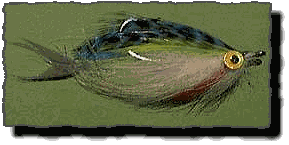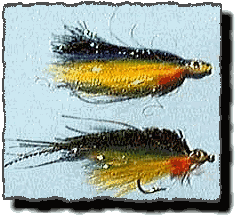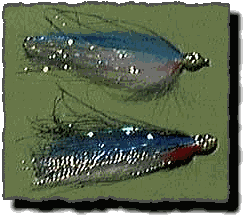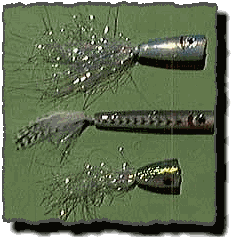Fly selection for East Cape is really pretty simple.
Your flies should represent your tackle and how you
plan to fish. For example, under certain conditions
Dorado travel in schools. The smaller fish are found
at the top of the school, in shallower water. If you
want to target the larger fish then you will have more
luck if you fish your flies deep. You can do this
with a shooting head system or by using clouser Minnows
or weighted flies. You can, of course, use both.
Clousers.
Another good beach fly and good for casting into
schools of dorado. This is a must have fly. 2-inch
to 5-inch in length.

There are two physical states that you will find the
fish. The normal state, in which the fish are simply
moving around, and a state in which they are "lit up".
You will see this "lit up" referred to in a lot of
articles about billfish. However, billfish are not
the only fish you can light up. Dorado, and roosterfish
will also light up for you. In this state the fish
is excited and interested in a meal. At times, when
the fish are lit up it almost seems that you could
throw a toilet seat out there and they would hit it.
They are not too discriminating during the lit up phase.
Two more generic flies tied in dorado colors.

At times the dorado will prefer flies tied in there
own colors. One here is a tube fly and the other is
a streaker.
Local guides will try and light up a school of fish by
chumming. This works especially well for Dorado. In
the normal state the fish aren't actively feeding but
will hit a target of opportunity. In this state it
helps to have a more accurate representation of the
local baitfish.
Croft's Baby Bull Dorado.
Large flies such as this can tease a billfish into striking.
You will recognize this as a variation of Ned Grays Streaker.
 Other good color combinations on large flies are mackerel
green-backed patterns, purple and white, pink and white,
black and white, as well as the standard blue and white.
Other good color combinations on large flies are mackerel
green-backed patterns, purple and white, pink and white,
black and white, as well as the standard blue and white.
By far the most important baitfish for this area is
the Sardinia. Imagine a short 4-inch heavy set
herring and you have a Sardinia. Two things to
remember about Sardinia. Every thing eats them
so they are 90% of your fly selection. Second, if
the Sardinia are around in large numbers your trip
is guaranteed. The most common size Sardinia comes
in right at 4 inches. This is perfect for bucktail
flies. When schools of Sardinia are pushed to the
surface by dorado or tuna, then sardine poppers can
be your best choice. The poppers have the ability
to call fish from a great distance, with the added
feature of a surface strike.
Croft's Marabou Sardinia.
Shown here in the brown phase. Usually this is a blue
and white fly. Tied completely out of marabou except
for the lateral line. This fly is impossible to
foul as it is set so far back on the shank of the
hook. Nothing here to
 interfere with the gape of the hook. Like all other
marabou flies it swims with great action.
interfere with the gape of the hook. Like all other
marabou flies it swims with great action.
Croft's East Cape Sardinia.
This fly has caught everything from sailfish to tuna.
It is a good fly for times when the fish are not lit
up and they like something more natural.
 ...And yes those are fish lips on this fly.
...And yes those are fish lips on this fly.
Two generic blue and white Sardinia patterns.
These two flies will give you 90% of your action.

Tied here tube style and traditionally with a stinger hook.
Of lesser importance in descending order are mackerel,
mullet and flying fish. Mullet and flying fish can
be duplicated with dark blue or black back over a white
or cream body. The mackerel has characteristic black
stripes down his body, so look for green dyed grizzly
for patterned striped backs on these flies. Mackerel
and flying fish are used mostly for sailfish, while
mullet are a favorite food of the roosterfish.
Unless you just can't stand them, tube flies are a
good choice. I don't use tube flies anywhere else
in the world except here. But the ability of the
fly to slide up and out of the fishes mouth is a
great feature of these flies. When fishing is hot,
some fish can chew up a whole lot of standard flies
in a day.
Smaller 2 and 3-inch clousers, or weighted flies
work well from the shore. Poppers cast from the
shore will also pick up the occasional rooster
fish. These patterns can simply be scaled down
versions of Sardinia.
Poppers.
Good beach flies and for times when the sardines are
about and being pushed to the surface. These can be
indispensable. You want at least a half dozen.

That in a nut shell is the 25 cent tour of Baja flies.
For those who are tying your own flies be aware that
no material is sacred. They all work. Color and size
are important. Most important of all is FLASH!!! Don't
skimp on your mylar flashabou or crystal flash.
Also don't store your flies in dark plastic boxes.
Expect temperatures close to 100 degrees. At
temperatures over 140 degrees the mylar will start to
curl. It doesn't take much imagination to figure
what would happen to a black flybox left in the sun
unattended for a few hours.
~Mike Croft
Mike and 400 Flies for Cape
 Part 1|
Part 2|
Part 4|
Part 1|
Part 2|
Part 4|
|











